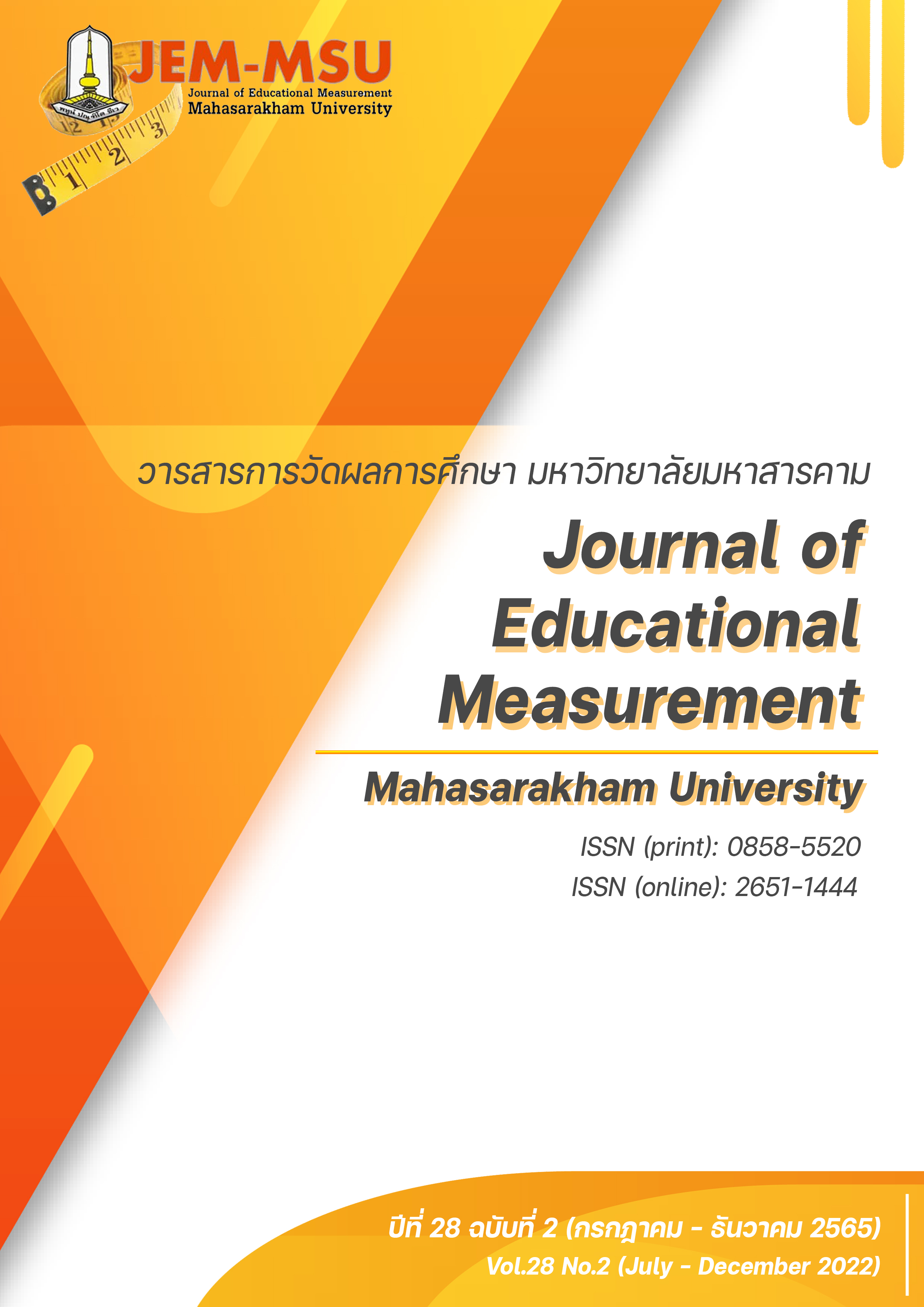การศึกษาความเหนื่อยหน่ายในการเรียนของนิสิต มหาวิทยาลัยมหาสารคาม (Retracted)
Main Article Content
บทคัดย่อ
การวิจัยนี้ มีวัตถุประสงค์เพื่อ (1) ศึกษาระดับความเหนื่อยหน่ายในการเรียนของนิสิตมหาวิทยาลัยมหาสารคาม (2) เปรียบเทียบความเหนื่อยหน่ายในการเรียนของนิสิตมหาวิทยาลัยมหาสารคามจำแนกตามเพศและกลุ่มคณะ และ (3) ศึกษาแนวทางในการจัดการความเหนื่อยหน่ายในการเรียนของนิสิตมหาวิทยาลัยมหาสารคาม ตัวอย่างที่ใช้ในการศึกษาเป็นนิสิตระดับปริญญาตรี มหาวิทยาลัยมหาสารคามทุกชั้นปีที่กำลังศึกษาในปีการศึกษา 2563 จำนวน 1,080 คน โดยใช้การสุ่มตัวอย่างแบบแบ่งชั้นตามกลุ่มคณะ เครื่องมือที่ใช้ในการวิจัย คือ แบบสอบถามความเหนื่อยหน่ายในการเรียน และแบบสัมภาษณ์แนวทางในการจัดการความเหนื่อยหน่ายในการเรียนของนิสิตมหาวิทยาลัยมหาสารคาม โดยใช้วิธีการสนทนากลุ่มในการเก็บรวบรวมข้อมูลจากผู้มีส่วนใดส่วนเสีย จำนวน 9 คน และวิเคราะห์ข้อมูลโดยใช้การวิเคราะห์เชิงเนื้อหา สถิติที่ใช้ในการวิเคราะห์ข้อมูล ได้แก่ ค่าเฉลี่ย ส่วนเบี่ยงเบนมาตรฐาน t – test และ F – test
ผลการวิจัยพบว่า
1. ความเหนื่อยหน่ายในการเรียนของนิสิตระดับปริญญาตรีโดยรวม (M = 3.70, SD = 0.60) อยู่ในระดับมาก
2. ความเหนื่อยหน่ายในการเรียนของนิสิตระดับปริญญาตรีจำแนกตามเพศ นิสิตระดับปริญญาตรีเพศชายและเพศหญิงมีความเหนื่อยหน่ายในการเรียนแตกต่างกันอย่างมีนัยสำคัญทางสถิติที่ระดับ .05 โดยเพศชาย (M = 3.81, SD = 0.47) มีความเหนื่อยหน่ายในการเรียนมากกว่าเพศหญิง (M = 3.63, SD = 0.66)
3. ความเหนื่อยหน่ายในการเรียนของนิสิตระดับปริญญาตรีจำแนกตามกลุ่มคณะ นิสิตระดับปริญญาตรีที่มีกลุ่มคณะแตกต่างกันมีความเหนื่อยหน่ายในการเรียนแตกต่างกันอย่างมีนัยสำคัญทางสถิติที่ระดับ .05 โดยความเหนื่อยหน่ายในการเรียนของกลุ่มวิทยาศาสตร์และเทคโนโลยี (M = 3.87, SD = 0.37) มีค่าเฉลี่ย มากที่สุด กลุ่มมนุษยศาสตร์และสังคมศาสตร์มีค่าเฉลี่ยรองลงมา (M = 3.70, SD = 0.62) และกลุ่มวิทยาศาสตร์สุขภาพ (M = 3.33, SD = 0.72) มีค่าเฉลี่ยน้อยที่สุด
4. แนวทางในการจัดการความเหนื่อยหน่ายในการเรียนของนิสิตทั้งในการสอนในห้องเรียน และระบบออนไลน์ อาจารย์ผู้สอนต้องมีการกำกับติดตาม การโต้ตอบ ซักถาม เปิดโอกาสให้นิสิตตั้งคำถาม การแลกเปลี่ยนเรียนรู้โดยมีอาจารย์ผู้สอนเป็นผู้ควบคุมการเรียนการสอนให้เป็นไปตามแผนที่กำหนดไว้ มีการใช้สื่อการสอนที่ทำให้ผู้เรียนสามารถสื่อสารระหว่างผู้เรียนกับผู้สอน และระหว่างผู้เรียน รวมถึงการนำเสนอประเด็นความรู้ที่เกี่ยวข้องกับรายวิชาที่สอนเพื่อการอภิปรายร่วมกัน นอกจากนี้อาจารย์ผู้สอนต้องติดตามนิสิตที่มีปัญหาเกี่ยวกับการเรียน ปัญหาส่วนตัว และสังคมเพื่อสร้างสัมพันธภาพที่ดี การให้การปรึกษา การให้ข้อเสนอแนะที่จะช่วยลดความเหนื่อยหน่ายในการเรียนได้
Article Details

This work is licensed under a Creative Commons Attribution-NonCommercial-NoDerivatives 4.0 International License.
เนื้อหาและข้อมูลในบทความที่ลงตีพิมพ์ในวารสารการวัดผลการศึกษา มหาวิทยาลัยมหาสารคาม ถือเป็นข้อคิดเห็นและความรับผิดชอบของผู้เขียนบทความโดยตรง ซึ่งกองบรรณาธิการวารสาร ไม่จำเป็นต้องเห็นด้วย หรือร่วมรับผิดชอบใดๆ
บทความ ข้อมูล เนื้อหา รูปภาพ ฯลฯ ที่ได้รับการตีพิมพ์ในวารสารการวัดผลการศึกษา มหาวิทยาลัยมหาสารคาม ถือเป็นลิขสิทธิ์ของวารสารการวัดผลการศึกษา มหาวิทยาลัยมหาสารคาม หากบุคคลหรือหน่วยงานใดต้องการนำทั้งหมดหรือส่วนใดส่วนหนึ่งไปเผยแพร่ต่อหรือกระทำการใดๆ จะต้องได้รับอนุญาตเป็นลายลักษณ์อักษรจากวารสารการวัดผลการศึกษา มหาวิทยาลัยมหาสารคาม ก่อนเท่านั้น
References
Barrow, J. C., & Prosen, S. S. (1981). A Model of Stress and Counseling Interventions. Personnel and Guidance Journal, 60(1), 5-10.
Ezenwaji, I. O., Eseadi, C., Ugwoke, S. C., Vita-Agundu, U. C., Edikpa, E., Okeke, F. C., Nwafor, B. N., Ozioko, A. N., Ebinyasi, J. O. Nwabuko, L. O., Njoku, L. G., & Agu, M. A. (2019). A Group-Focused Rational Emotive Behavior Coaching for Management of Academic Burnout among Undergraduate Students Implications for School Administrators. Medicine, 98(30), 1-9.
Fares, J., Tabosh, H. A., Saadeddin, Z., Christopher, M. E., & Aridi, H. (2016). Stress, Burnout and Coping Strategies in Preclinical Medical Students. North American Journal of Medical Sciences, 8(2), 75-81.
Heikkila, A. (2011). University Students’ Approaches to Learning, Self-Regulation, and Cognitive and Attributional Strategies: Connections with Well-Being and Academic Success [Academic Dissertation]. University of Helsinki.
Herrmann, J., Koeppen, K., & Kessels, U. (2019). Do Girls Take School Too Seriously? Investigating Gender Differences in School Burnout from A Self-Worth Perspective. Learning and Individual Differences, 69, 150-161.
Kinslow, K., Sutherland, M., McKenny, M., & Elkbuli, A. (2020). Reported Burnout among U.S. General Surgery Residents: A Survey of The Association of Program Directors in Surgery Members. Annals of Medicine and Surgery, 60, 14-19.
Ladstatter, F., & Garrosa, E. (2008). Prediction of Burnout: An Artificial Neural Network Approach. Diplomica Verlag GmbH.
Law, D. W. (2010). A Measure of Burnout for Business Students. Journal of Education for Business, 85, 195-202.
Lin, S., & Huang, Y. (2014). Life Stress and Academic Burnout. Active Learning in Higher Education, 15(1), 77-90.
Ling, C., Lan, J., Zhu-hui, Y., & Nan, L. (2013). A Survey on College English Learning Burnout. Sino-US English Teaching, 10(8), 608-614.
Maslach, C., Shaufeli, W. B., & Leiter, M. P. (2001). Job Burnout. Annual Review of Psychology, 52, 397-422.
Pala, A. (2012). The Burnout Level among Faculty of Education Students at Celal Bayar University. Procedia-Social and Behavioral Sciences, 69, 1766-1774.
Palos, R., Maricutoiu, L. P., & Costea, I. (2019). Relations between Academic Performance, Student Engagement and Student Burnout: A Cross-Lagged Analysis of a Two-Wave Study. Studies in Educational Evaluation, 60, 199-204.
Purvanova, R. K., & Muros, J. P. (2010). Gender Differences in Burnout: A Meta-Analysis. Journal of Vocational Behavior, 77, 168-185.
Salmela-Aro, K., Kiuru, N., & Nurmi, J. (2008). The Role of Educational Track in Adolescents' School Burnout: A Longitudinal Study. British Journal of Educational Psychology, 78, 663-689.
Salmela-Aro, K., Kiuru, N., Leskinen, E., & Nurmi J. (2009). School-Burnout Inventory (SBI): Reliability and Validity. European Journal of Psychological Assessment, 25(1), 48-57.
Widlund, A., Tuominen, H., Tapola, A., & Korhonen J. (2020). Gendered Pathways from Academic Performance, Motivational Beliefs, and School Burnout to Adolescents' Educational and Occupational Aspirations. Learning and Instruction, 66, 1-12. https://doi.org/10.1016/j.learninstruc.2019.101299
Office of SMEs Promotion. (2017). Burnout Syndrome: Dig into Marketing Strategy, Refuel Workers’ Energy. SME ONE. https://www.smeone.info/detail-article/8008?fbclid=IwAR 3cNeoZjKM9Y51i3KEvtoFun6KXAC5QEshUCt60fSD0yLFIdeDzR9v5h6w (in Thai)
Office of the Education Council. (2017). Thai Education Competency in the Global Arena in 2016 (IMD 2016). Office of the Education Council. (in Thai)
Office of the National Economic and Social Development Council. (2017, May 1). Projection of Graduates and New Workforce Entries in 2010-2018 Classified by Levels of Education. m-society. https://www.m-society.go.th/news_view.php?nid=19451 (in Thai)
Sea-oui, K. (2011). Factors Predicting Counselors' Burnout in the Upper Northern Region of Thailand. Journal of Clinical Psychology, 42(2), 19-31. (in Thai)
Seree, P. (2015). Study Problems. In Sitdhiraksa, N., Wannasewok, K., Wannarit, K., Pukrittakayamee, P., Apinuntavech, S., & Katumarn, P. (eds.). Siriraj psychiatry DSM-5. (pp. 311-325). Department of Psychiatry, Mahidol University. (in Thai)
Simachokedee, W. (2016, June 16). 21st Century Studying. PostToday, p. B2. (in Thai)
Thai Children are Bored of Studying and Teachers. (2014, April 24). PostToday, p. A6. (in Thai)

